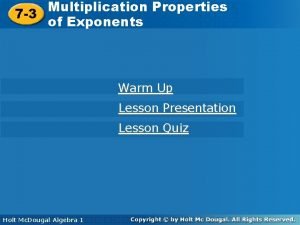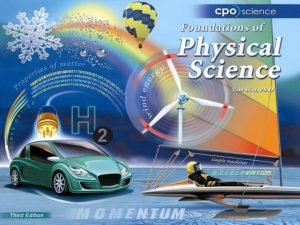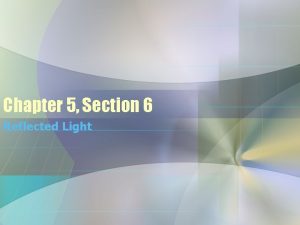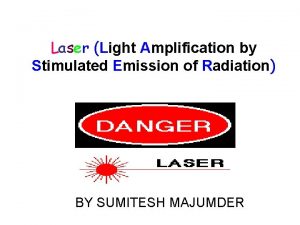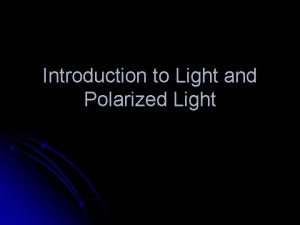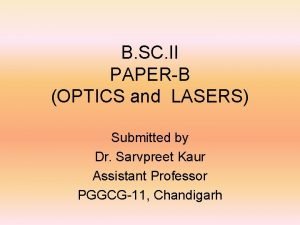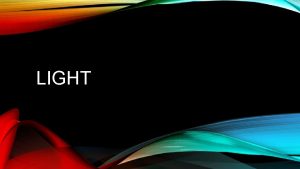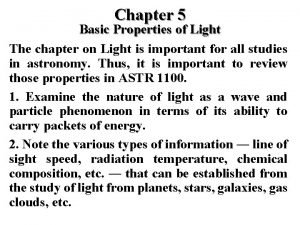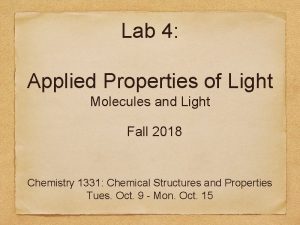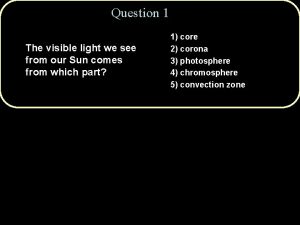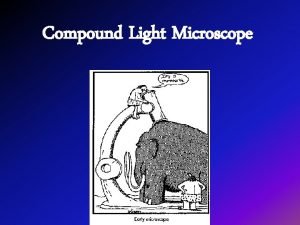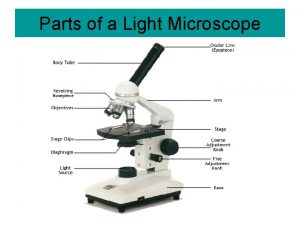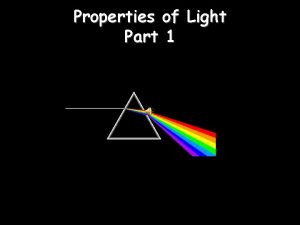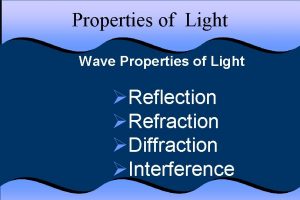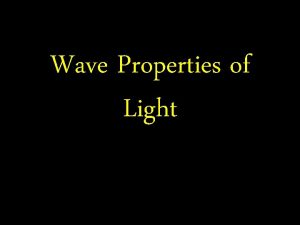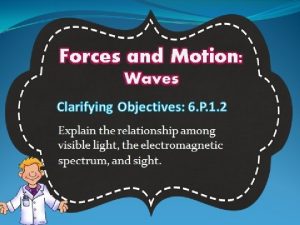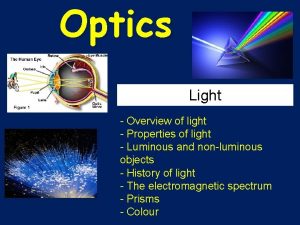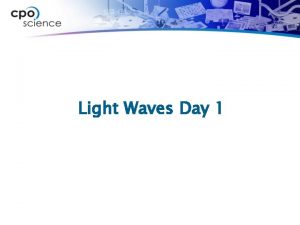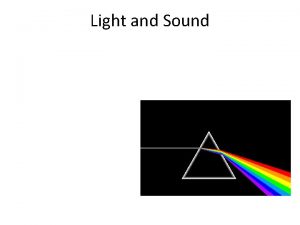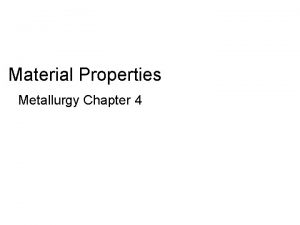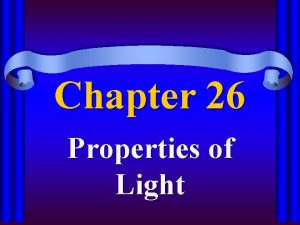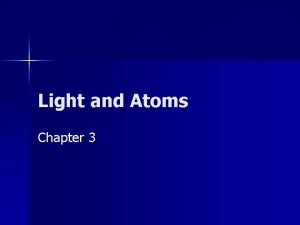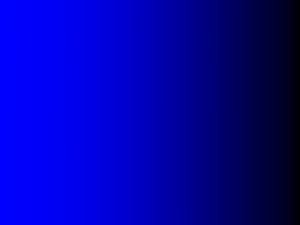Chapter 26 Properties of Light Part VI Light






























- Slides: 30

Chapter 26 Properties of Light Part VI: Light is the only thing we see, sound is the only thing we hear.

Light originates from the accelerated motion of electrons.

Electromagnetic Waves Moving charges (currents) create magnetic fields. Oscillating magnetic fields create electric fields. These effects create electromagnetic waves.

Electromagnetic Wave Animation Fig. 26. 2 Light is a

Electromagnetic Spectrum Cell phone Very broad spectrum of electromagnetic waves

The Electromagnetic Spectrum

The Electromagnetic Spectrum Animation Fig. 26. 3

Speed of Light Speed of light is 300, 000 m/s Since, A radio station at 100 Megahertz has

Speed of Light If it slows down: ◦ The electric and magnetic fields will become weaker and the wave will die out. If it speeds up: ◦ The electric and magnetic fields will get stronger and stronger with an increasing energy, this is contradictory to the conservation of energy law. At 3 x 108 m/s the electric and magnetic fields mutually induce/regenerate each other without a loss or gain in energy.

Wavelengths of red, green and violet Fig. 26. 4 Animation

Light is an energy-carrying electromagnetic wave that emanates from vibrating electrons in atoms.

Light and Vibration: Fig 26. 5 Sound-vibration from emitter, transmitted to the receiver. Light-force electrons in materials to vibrate

Transparent Materials Glass and water Light passes through in straight lines. Atoms in glasselectrons attached to nucleus by “springs”

Light and Transparent Materials Light travels at difference average speeds through different materials.

Visible light incident on glass Fig. 26. 7

Light travels at: C=3 x 108 m/s. 75 C. 67 C. 41 C in a vacuum/air in water in glass in a diamond After it moves through a material, it speeds back up to C (in air).

Every material absorbs and reflects visible light or any electromagnetic wave differently. Depends on: 1. Natural frequency of electrons in the material 2. Frequency of the incident electromagnetic wave

Glass blocks ultraviolet and infrared waves Fig. 26. 8

Opaque Materials Opaque – materials that absorb light without reemitting it. Ex. Rubber, you, and metal are opaque (rubber absorbs, metal reflects) Some opaque materials absorb certain waves while other materials reflect those electromagnetic waves. Fig. 26. 9

Ultraviolet Waves Higher frequency than visible light. Types: 1. UV-A – longer wavelength (close to viable light) not harmful 2. UV-B-intermediate wavelength, sunburn, eye damage, skin cancer 3. UV-C – short wavelength, blocked by ozone layer

Shadows Size and sharpness of a shadow depends on size and distance of light source and of object casting the shadow.

Ray Tracing for Shadows Trace rays from light source to wall to map out location of deep shadow (umbra) and fuzzy shadow (penumbra). Light source Object Wall Penumbra UMBRA Penumbra

1. 2. Small nearby or large far away light source produces a sharp shadow. Large nearby source produces a fuzzy shadow.

Eclipses Earth and moon cat a shadow when the sun shines on them. Eclipses – when either the moon or the earth is in the way of the other’s shadow.

Fig. 26. 12 Animation

Solar Eclipse Animation

The Eye Cornea – transparent cover, 70% of light bending Lens – focus Retina – sensitive, layer on back of eye Fovea – distinct vision, detail

Blind Spot (Fig. 26. 15)

Figure 26. 21 pg. 510

Chapter 26 Review: 3, 6, 9, 12, 16, 17, 19, 22, 24, 25 Exercises: 1, 4, 5, 7, 12, 13, 14, 16 – 19 all, 22, 24, 29, 32, 35 Problems: 6, 7
 Light light light chapter 23
Light light light chapter 23 Light light light chapter 22
Light light light chapter 22 Light light light chapter 22
Light light light chapter 22 Extensive examples
Extensive examples Chemical property definition
Chemical property definition More multiplication properties of exponents quiz part 1
More multiplication properties of exponents quiz part 1 3-2 properties of parallel lines
3-2 properties of parallel lines Addition symbol
Addition symbol Part to part ratio definition
Part to part ratio definition Part part whole
Part part whole Technical description
Technical description Under bar layout
Under bar layout The phase of the moon you see depends on ______.
The phase of the moon you see depends on ______. 미니탭 gage r&r 해석
미니탭 gage r&r 해석 U
U What are the 7 properties of light
What are the 7 properties of light 5 properties of light
5 properties of light Properties of laser light
Properties of laser light Stimulated emission
Stimulated emission What is the light
What is the light Properties of laser light
Properties of laser light Properties of light
Properties of light Basic properties of light
Basic properties of light What are the properties of light
What are the properties of light Ophthalmology medical terminology
Ophthalmology medical terminology Properties of light lab
Properties of light lab The visible light we see from our sun comes from which part
The visible light we see from our sun comes from which part Light microscope part
Light microscope part Microscope
Microscope Put out the light and then put out the light meaning
Put out the light and then put out the light meaning Membrane-bound organelles
Membrane-bound organelles





